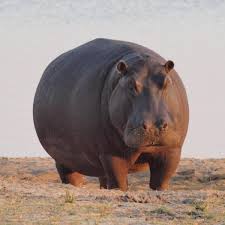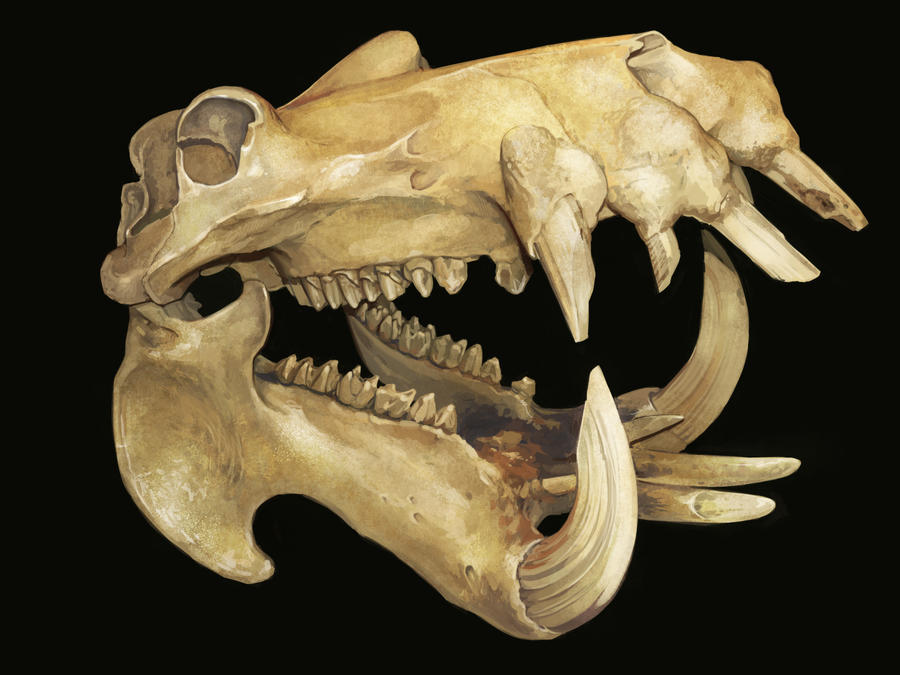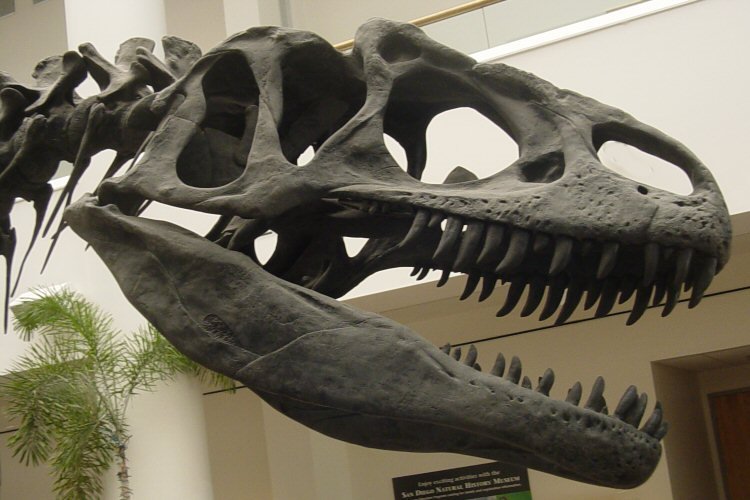Post by dinosauria101 on Feb 3, 2019 2:36:58 GMT 5
Hippopotamus - Hippopotamus amphibius
The hippopotamus (Hippopotamus amphibius), or hippo, from the ancient Greek for "river horse" (ἱπποπόταμος), is a large, mostly herbivorous mammal in sub-Saharan Africa, and one of only two extant species in the family Hippopotamidae (the other is the Pygmy Hippopotamus.) After the elephant and rhinoceros, the hippopotamus is the third largest land mammal and the heaviest extant artiodactyl. The hippopotamus is semi-aquatic, inhabiting rivers, lakes and mangrove swamps where territorial bulls preside over a stretch of river and groups of 5 to 30 females and young. During the day they remain cool by staying in the water or mud; reproduction and childbirth both occur in water. They emerge at dusk to graze on grass. While hippopotamuses rest near each other in the water, grazing is a solitary activity and hippos are not territorial on land. The hippopotamus is recognizable by its barrel-shaped torso, enormous mouth and teeth, nearly hairless body, stubby legs and tremendous size. It is the third largest land mammal by weight (between 1½ and 3 tonnes), behind the white rhinoceros (1½ to 3½ tonnes) and the three species of elephant (3 to 9 tonnes). The hippopotamus is one of the largest quadrupeds (four legged mammals). Despite its stocky shape and short legs, it can easily outrun a human. Hippos have been clocked at 30 km/h (19 mph) over short distances. The hippopotamus is one of the most aggressive creatures in the world and is often regarded as one of the most dangerous animals in Africa. There are an estimated 125,000 to 150,000 hippos throughout Sub-Saharan Africa; Zambia (40,000) and Tanzania (20,000–30,000) possess the largest populations. They are still threatened by habitat loss and poaching for their meat and ivory canine teeth. Hippopotamuses are among the largest living mammals; only elephants and some rhinoceroses and whales are heavier. They can live in the water or on land. Their specific gravity allows them to sink and walk or run along the bottom of a river. Hippos are considered megafauna, but unlike all other African megafauna, hippos have adapted for a semi-aquatic life in freshwater lakes and rivers. Because of their enormous size, hippopotamuses are difficult to weigh in the wild. Most estimates of the weight come from culling operations that were carried out in the 1960s. The average weight for adult males is 1,500 kg (3,300 lb). Females are smaller than their male counterparts, with average weights measuring between 1,300–1,500 kg (2,900–3,300 lb). Older males can get much larger, reaching at least 3,200 kg (7,100 lb) and occasionally weighing 4,500 kg (9,900 lb). Male hippos appear to continue growing throughout their lives; females reach a maximum weight at around age 25.

Allosaurus fragilis
Allosaurus is a genus of carnivorous theropod dinosaur that lived 155 to 150 million years ago during the late Jurassic period (Kimmeridgian to early Tithonian). Allosaurus was a typical large theropod, having a massive skull on a short neck, a long tail and reduced forelimbs. Allosaurus fragilis, the best-known species, had an average length of 8.5 m (28 ft), with the largest definitive Allosaurus specimen (AMNH 680) estimated at 9.7 meters (32 feet) long, and an estimated weight of 2.3 metric tons (2.5 short tons). As with dinosaurs in general, weight estimates are debatable, and since 1980 have ranged between 1,500 kilograms (3,300 pounds), 1,000 to 4,000 kg (2,200 to 8,800 lb), and 1,010 kilograms (2,230 pounds) for modal adult weight (not maximum). Using the subadult specimen nicknamed "Big Al", researchers using computer modelling arrived at a best estimate of 1,500 kilograms (3,300 lb) for the individual, but by varying parameters they found a range from approximately 1,400 kilograms (3,100 lb) to approximately 2,000 kilograms (4,400 lb).

Credit to Wikipedia
The hippopotamus (Hippopotamus amphibius), or hippo, from the ancient Greek for "river horse" (ἱπποπόταμος), is a large, mostly herbivorous mammal in sub-Saharan Africa, and one of only two extant species in the family Hippopotamidae (the other is the Pygmy Hippopotamus.) After the elephant and rhinoceros, the hippopotamus is the third largest land mammal and the heaviest extant artiodactyl. The hippopotamus is semi-aquatic, inhabiting rivers, lakes and mangrove swamps where territorial bulls preside over a stretch of river and groups of 5 to 30 females and young. During the day they remain cool by staying in the water or mud; reproduction and childbirth both occur in water. They emerge at dusk to graze on grass. While hippopotamuses rest near each other in the water, grazing is a solitary activity and hippos are not territorial on land. The hippopotamus is recognizable by its barrel-shaped torso, enormous mouth and teeth, nearly hairless body, stubby legs and tremendous size. It is the third largest land mammal by weight (between 1½ and 3 tonnes), behind the white rhinoceros (1½ to 3½ tonnes) and the three species of elephant (3 to 9 tonnes). The hippopotamus is one of the largest quadrupeds (four legged mammals). Despite its stocky shape and short legs, it can easily outrun a human. Hippos have been clocked at 30 km/h (19 mph) over short distances. The hippopotamus is one of the most aggressive creatures in the world and is often regarded as one of the most dangerous animals in Africa. There are an estimated 125,000 to 150,000 hippos throughout Sub-Saharan Africa; Zambia (40,000) and Tanzania (20,000–30,000) possess the largest populations. They are still threatened by habitat loss and poaching for their meat and ivory canine teeth. Hippopotamuses are among the largest living mammals; only elephants and some rhinoceroses and whales are heavier. They can live in the water or on land. Their specific gravity allows them to sink and walk or run along the bottom of a river. Hippos are considered megafauna, but unlike all other African megafauna, hippos have adapted for a semi-aquatic life in freshwater lakes and rivers. Because of their enormous size, hippopotamuses are difficult to weigh in the wild. Most estimates of the weight come from culling operations that were carried out in the 1960s. The average weight for adult males is 1,500 kg (3,300 lb). Females are smaller than their male counterparts, with average weights measuring between 1,300–1,500 kg (2,900–3,300 lb). Older males can get much larger, reaching at least 3,200 kg (7,100 lb) and occasionally weighing 4,500 kg (9,900 lb). Male hippos appear to continue growing throughout their lives; females reach a maximum weight at around age 25.
Allosaurus fragilis
Allosaurus is a genus of carnivorous theropod dinosaur that lived 155 to 150 million years ago during the late Jurassic period (Kimmeridgian to early Tithonian). Allosaurus was a typical large theropod, having a massive skull on a short neck, a long tail and reduced forelimbs. Allosaurus fragilis, the best-known species, had an average length of 8.5 m (28 ft), with the largest definitive Allosaurus specimen (AMNH 680) estimated at 9.7 meters (32 feet) long, and an estimated weight of 2.3 metric tons (2.5 short tons). As with dinosaurs in general, weight estimates are debatable, and since 1980 have ranged between 1,500 kilograms (3,300 pounds), 1,000 to 4,000 kg (2,200 to 8,800 lb), and 1,010 kilograms (2,230 pounds) for modal adult weight (not maximum). Using the subadult specimen nicknamed "Big Al", researchers using computer modelling arrived at a best estimate of 1,500 kilograms (3,300 lb) for the individual, but by varying parameters they found a range from approximately 1,400 kilograms (3,100 lb) to approximately 2,000 kilograms (4,400 lb).

Credit to Wikipedia









